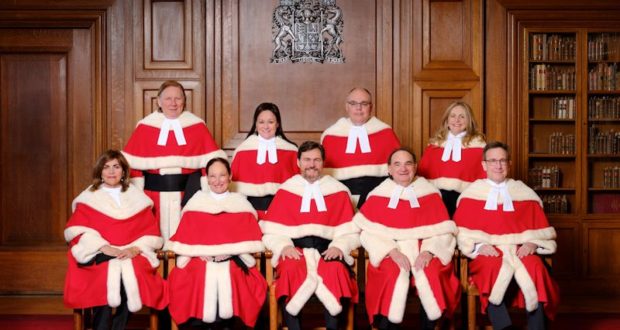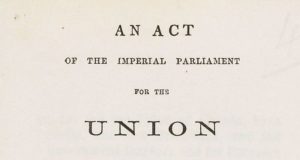Humans often don’t evaluate an experience in light of how good it is, but rather against how much it met/failed to meet/exceeded our expectations. And on that front, the Supreme Court’s decision in Minister of Citizenship and Immigration v Vavilov delivered in spades. After years of lamenting administrative law decisions coming from the Supreme Court, we have what looks like a workable framework – one that appears a theoretical improvement over what came before, but also one that recognizes the reality of the modern administrative state.
So on this Christmas Eve Eve, I’m going to begin a list of twenty things I’m thankful for about Vavilov. I began this list on Twitter earlier, but expansion seems necessary. This will take a while, and thus will take three posts, with the others following for your holiday entertainment. So, without further ado…
1)Compromise is still possible: Let’s begin with the reason for my surprise – the fact that seven judges, who had displayed serious ideological disagreements regarding the framework of standard of review, managed to agree in a strong set of reasons. It was no surprise to see Justices Côté, Brown, and Rowe arguing for greater instances of correctness review – but it was equally surprising to see them acknowledge that reasonableness reviews should remain the default. The Chief Justice and Justice Gascon starting from a presumption of reasonableness was to be expected, but I was perhaps surprised to see them go into such depth about the importance of the rule of law, and it calling for correctness review in certain circumstances. Joined by Justices Moldaver (who has waffled on this issue) and Martin (about whom we had little track record), what we are left with is a strong majority opinion that one hopes will not fracture merely because the composition of the court changes. The majority agreed about most first principles, and a framework that seems to be principled and predictable.
2) Teachable: Start with context. Or start with a presumption and see if an exception applies. But remember indeterminate other factors. The Dunsmuir framework (and, more notably, the cases that followed Dunsmuir) were a nightmare to teach, much less advise clients on. (Having taught and practiced administrative law, there’s an overlap between those two things.) Now, however, we know that there is no “contextual analysis” but rather a presumption of reasonableness review. But there are clearly defined exceptions in cases of defined standards of review, statutory appeals, and where the rule of law requires a “correct” answer, such as in constitutional cases, or where two administrative tribunals issue contradictory orders. This is barely a simplification, and can easily be explained to students and clients.
As I have argued in a paper (shortly to be published in the Queen’s Law Journal) on appellate jurisdiction in civil appeals:
A rule that says “If X, then Y; If not X, then Z” may be too simple. A rule that says “Consider A, B, C, D, E, F, G, and H and then do what is fair and just” may be too amorphous. But there are middle ways, such as “If X, then Y; If not X, then Z. Unless one of L, M, N, O, or P is present, then do Y even though X is not also present”. So long as the presence of “L, M, N, O, and P” can be determined with reasonable predictability, this seems eminently reasonable and predictable.
This is essentially what the Supreme Court has now prescribed, and it is to be commended.
3) No more “true questions of jurisdiction”: Surely an administrator cannot make a decision that it had no jurisdiction to make, or to begin an inquiry on which it had no authority to embark? The near self-evident nature of this led to the Supreme Court confidently declaring that this was to remain a distinct category of correctness review in Dunsmuir. But determining this line proved incredibly difficult in practice and the classroom. And from a pragmatic perspective, when an administrator clearly has exceeded its authority, it has almost certainly acted unreasonably. So however theoretically unsatisfying it seems to jettison this category of decisions to be reviewed on a correctness standard, this seems an instance where analytical purity can justly give way to reality on the ground. The majority wisely quoted the Supreme Court of the United States in City of Arlington, Texas v Federal Communications Commission:
The fox-in-the-henhouse syndrome is to be avoided not by establishing an arbitrary and undefinable category of agency decision-making that is accorded no deference, but by taking seriously, and applying rigorously, in all cases, statutory limits on agencies’ authority. Where [the legislature] has established a clear line, the agency cannot go beyond it; and where [the legislature] has established an ambiguous line, the agency can go no further than the ambiguity will fairly allow. But in rigorously applying the latter rule, a court need not pause to puzzle over whether the interpretive question presented is “jurisdictional” . . .
4) A Purposive Approach to Stare Decisis:The role of stare decisis is clearly one close to ARL’s heart. Both the majority and the concurrence justly praised its role in achieving legal certainty and predictability, and thus upholding the rule of law. Stare decisis also upholds democracy, as legislatures are generally free to amend court decisions with which they disagree. Their silence generally (though not always, as will be discussed later) can be considered acquiescence.
But nor is stare decisis absolute. There are reasons to depart from precedent, first among them being that the earlier decision was clearly erroneous, and/or has proven difficult to apply in practice. When both of these criteria are present – as many intervenors submitted was the case with respect to Dunsmuir and its progeny – the case for departing from precedent is particularly strong. For the rationale behind state decisis – certainly and predictability – are served by a departure from precedent rather than blind adherence to it. That may not be the case often, but it was the case here.
5) The rule of law and the purpose of judicial review generally: We were all taught in administrative law that there is no such thing as “absolute and untrammeled discretion” in Canadian law. Roncarelli v Duplessis iconically stands for this proposition. Rather, the rule of law mandates that courts be able to review administrative decisions, even when privative clauses purport to prohibit that. This constitutional principle now joins the textually clear instances of prescribed standards of review and appeal rights as the third instance where correctness review continues.
6) A defence of textualism generally: But purpose doesn’t arise in a vacuum. It is best discerned by language, which provides precision and was not accidentally chosen by the legislature. Not only does this mandate giving effect to statutorily prescribed standards of review and appeal routes, but language will also feature prominently in any reasonableness analysis. This was said explicitly by Valivov’s majority, noting how statutory language will determine what will and will not be a reasonable decision.
7) Recognition of the difference between textualism and strict constructualism: But just as purpose does not arise in a vacuum, nor does text. The majority acknowledged that if one read s. 3(2)(a) of the Citizenship Act in perfect isolation, Alexander Vavilov may not be a citizen of Canada as his parents were “employee[s] in Canada of a foreign government”. But despite some American Republican lawmakers purporting to believe that “strict constructualism” is a virtue, it is hard to disagree with Antonin Scalia’s statement that “no one ought to be” a strict constructualist. This case illustrates why.
First, the government’s proposed interpretation of s. 3(2)(a) is belied by s. 3(2)(c), which contemplates that those in s. 3(2)(a) were those with diplomatic immunities at international law (immunities that more explicitly mentioned persons in s. 3(2)(a) clearly possessed). In and of itself, this belies the Registrar’s interpretation of s. 3(2)(a), and illustrates how purposes can be most precisely discerned from specific text. Moreover, the context of the legislation’s enactment rendered it obvious that it was to fulfill international legal obligations, which clearly meant to restrict birthright citizenship (from countries that grant it) only from those with diplomatic immunities. This fact ought not to trump clear text, but can certainly inform unclear text. Ultimately, while more elegant drafting could have made the meaning of s. 3(2)(a) clearer, there are shades of textual ambiguity, and this is not one.
I’ll leave it there for now. But a lucky thirteen further reflections will be coming over the holidays…
 Advocates for the Rule of Law
Advocates for the Rule of Law




One comment
Pingback: Applying Vavilov: Canada Post and Health and Safety - Daizy A. Bethea Law Firm | Barristers, Solicitors and Notary Public | lawyer2call